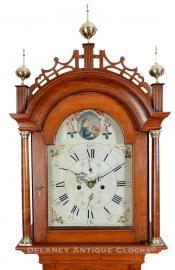A fine Connecticut River Valley tall clock made near Walpole, New Hampshire. (Isaiah Eaton?) 223072.
This late 18th-century tall case clock features a case constructed in cherry wood. This case form is distinctive because it features a very unusual base and foot design, incorporating five individual feet. Three other tall case examples are known to us that share this formatting. All four clocks have originated in the Walpole area of New Hampshire. One example is currently in the collection at Historic Deerfield. It is displayed upstairs in the Flynt Center of Early New England Life. That clock also features a cherry case and an engraved silvered dial signed by the Walpole, New Hampshire, clockmaker Isiah Eaton. The Charlestown, New Hampshire clockmaker Stephen Hasham made a second example, now privately owned. The Clockmaker signs This clock on its' engraved silvered brass dial. The third clock known to us is one we recently sold. It shares the same case design, and its painted dial was painted by the same hand that painted the dial of the clock we are now offering. Even the movement construction suggests that they came from the same workshop. Unfortunately, neither one of these painted dial examples is signed by the Clockmaker. Interestingly, these two clocks both have Walpole histories of ownership.
This case is the fourth of the clocks that share this case construction. The cherry case has masculine proportions. The cherry wood features a grain that varies in coloring. The modern shellac finish enhances this. This cabinet is elevated off the floor on a very unusual platform. This consists of a double-step molding applied to the base's lower section. This molding transitions into or forms five separate ogee bracket feet. The fifth foot is centered in the base between the front two feet. All five feet are not applied to the molding. They are scrolled out from the same piece of wood. The moldings and the feet are cut from the same piece of wood, which is very unusual, and the additional foot is a very unusual presentation. All five feet are original to this clock, boldly shaped, and include returns. The base panel features a figured cherry board that is formatted in a horizontal orientation. A scalloped molding hangs from below the lower waist molding. This decorative detail is often found on clocks made in the port city of Norwich, Connecticut, north up through Worcester, Massachusetts, and into the Connecticut River Valley region as Windsor, Vermont. The waist is section long and centers a large tombstone-shaped waist door. This door is trimmed with an applied molding. A fan is carved into the center of the door. This fan features a total of 20 radiants. This door provides access to the base-faced pendulum bob and the two drive weights. Boldly fluted quarter columns are mounted in the front corners of the waist. These terminate in turned wooden quarter capitals. The hood is designed with a molded cornice. A New England-style fretwork pattern is positioned above the arched molding. Three fluted finial plinths support this fret. Each plinth supports a brass ball-and-spike finial. The hood columns are turned smooth and mounted in brass capitals. These flank the arch-formed hood door. This door is fitted with glass. Additional columns are located at the back of the hood. This hood is also fitted with large tombstone-shaped sidelights.
The painted iron dial is of local origin. It is constructed from multiple pieces seamed together and cut into this traditional shape. This suggests that a professional dial maker did not make it. This is also reinforced by the artwork painted on the dial. The artist's hand is looser and less refined than the artwork found being produced in Boston, MA, and also in the city of Birmingham, England, at this time. This dial has a folk art quality to it. The spandrel decorations include colorful florals as a primary theme. This theme is also used in the lunette of the dial and helps center the portrait of an unidentified gentleman. He is depicted as very well-dressed and holding a flag in his right hand. I speculate that he may have been a resident familiar to the artist or the original owner of the clock. The time is displayed in a traditional format. Each of the five-minute markers is depicted in an Arabic form. These are separated from the Roman-style hour numerals by a dotted minute ring. A subsidiary seconds dial and calendar date display are inside the time ring. Nicely shaped steel hands will indicate the time.
This movement is constructed in brass and is of good quality. The large brass plates are supported by four turned posts. The plates have a rounded cutout at the bottom. This was often done to conserve brass. The front plate has an unusual mounting point for the calendar gearing. It is shaped in a "V" and is mounted to the front plate. This arrangement interacts with the display on the dial once every 24 hours. Hardened steel shafts support the polished steel pinions and brass gearing. The winding drums are grooved. The escapement is a recoil format. The movement is weight-driven and designed to run for eight days once fully wound. It is a two-train or a time-and-strike design, having a rack and snail striking system. As a result, it will strike each hour on a cast iron bell mounted on a post above the movement.
This case has the following dimensions: 95 inches tall to the top of the center finial. It is 20.5 inches wide and 10.5 inches deep at the upper bonnet molding. It was made circa 1810.
Inventory number 223072.




















